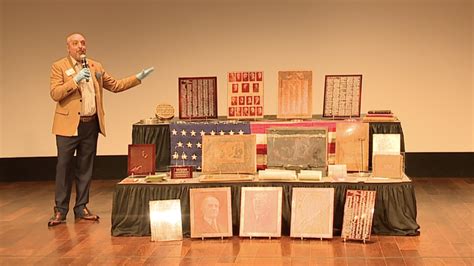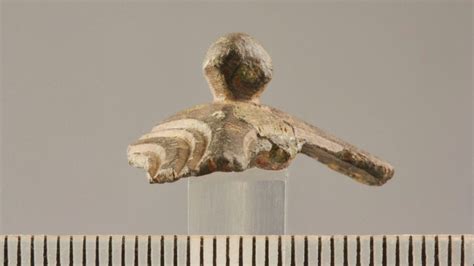
A remarkably preserved Roman bronze hand, dating back 1,600 years and adorned with intricate details, has been unearthed in Switzerland, captivating archaeologists with its exceptional condition and offering a unique glimpse into Roman life and metalworking techniques. The artifact, discovered in the canton of Graubünden, is believed to have been part of a larger statue, potentially depicting a deity or an important Roman figure, and represents an unprecedented find due to its nearly complete state and the level of detail retained.
The archaeological sensation emerged from excavations in the small town of Zizers, where ongoing investigations have been revealing a wealth of Roman-era artifacts. The bronze hand, measuring approximately 11 inches in length, showcases meticulously crafted fingers, delicate nail details, and subtle creases in the skin, indicating a high level of artistry and technical skill. According to the Archaeological Service of Graubünden, the hand’s exceptional preservation is attributed to a combination of factors, including the soil composition and the specific burial conditions at the site.
“The bronze hand is an extraordinary find,” stated Dr. Peter-Andrew Schwarz, the lead archaeologist overseeing the excavation. “Its condition is simply stunning, and the level of detail is unparalleled. It provides us with invaluable insights into Roman craftsmanship and artistic expression.” The discovery is particularly significant because complete or nearly complete bronze artifacts from this period are exceedingly rare, with most surviving examples being fragmented or heavily damaged.
The context of the find further enhances its importance. The hand was discovered alongside fragments of iron, bronze, and what appear to be remnants of a wooden structure. Archaeologists hypothesize that the hand was originally attached to a larger statue, possibly made of wood or stone, which was then clad in bronze. The statue may have stood in a public space, such as a temple or a forum, serving as a symbol of Roman power or religious devotion. The presence of other metal fragments suggests that the statue may have been deliberately dismantled or damaged, perhaps during a period of social or political upheaval.
Further analysis of the bronze hand is underway to determine its exact composition, manufacturing techniques, and original purpose. Experts are employing non-destructive methods, such as X-ray imaging and 3D scanning, to create a detailed digital model of the artifact. This will allow them to study the hand’s internal structure and identify any hidden features or inscriptions. The researchers also plan to compare the hand to other known Roman bronze artifacts to establish its stylistic characteristics and determine its place within the broader context of Roman art.
The discovery of the Roman bronze hand has generated considerable excitement among archaeologists and historians, who see it as a significant contribution to our understanding of Roman culture and technology. The artifact’s exceptional preservation and intricate details offer a unique opportunity to study Roman metalworking techniques and artistic sensibilities. It also raises intriguing questions about the identity of the statue’s subject and the circumstances surrounding its destruction. As research progresses, the bronze hand is expected to reveal further insights into the lives and beliefs of the people who inhabited Roman Switzerland 1,600 years ago.
The canton of Graubünden, where the hand was found, was once part of the Roman province of Raetia, a strategically important region that connected Italy with the northern parts of the Roman Empire. Roman settlements flourished in the area from the 1st to the 5th centuries AD, leaving behind a rich archaeological heritage. The discovery of the bronze hand underscores the importance of continued archaeological research in the region and highlights the potential for further discoveries that could shed light on Roman history.
The Archaeological Service of Graubünden plans to exhibit the bronze hand in a local museum, allowing the public to appreciate its beauty and historical significance. The exhibition will also showcase other Roman-era artifacts discovered in the region, providing visitors with a comprehensive overview of Roman life in Switzerland. The bronze hand is expected to become a major attraction, drawing tourists and scholars alike to the canton of Graubünden and further enhancing its reputation as a center for archaeological research.
The find also underscores the importance of preserving archaeological sites and protecting them from looting and development. Archaeological artifacts are a valuable source of information about the past, and their loss can deprive us of important insights into human history. By supporting archaeological research and promoting responsible stewardship of cultural heritage, we can ensure that these treasures are preserved for future generations. The bronze hand serves as a powerful reminder of the rich and complex history that lies beneath our feet, waiting to be discovered.
The researchers are particularly interested in the potential connection of the hand to a specific Roman deity or historical figure. Analyzing the style, size, and context of the artifact, they hope to narrow down the possibilities. While definitive identification remains elusive, several theories are being explored. One hypothesis suggests that the hand belonged to a statue of Jupiter, the king of the gods in Roman mythology. Jupiter was often depicted holding a scepter or thunderbolt in his hand, and the bronze hand’s size and craftsmanship would be consistent with such a representation. Another theory proposes that the hand belonged to a statue of a Roman emperor or other high-ranking official. Roman emperors were frequently honored with statues in public places, and the bronze hand could have been part of such a monument.
Regardless of its precise identity, the bronze hand is a testament to the skill and artistry of Roman metalworkers. The level of detail and craftsmanship evident in the artifact is remarkable, particularly considering the technological limitations of the time. Roman metalworkers were highly skilled in a variety of techniques, including casting, hammering, and engraving. They used a variety of materials, including bronze, iron, silver, and gold, to create a wide range of objects, from weapons and tools to jewelry and statues. The bronze hand is a prime example of their mastery of these techniques.
The discovery also raises questions about the fate of the statue to which the hand belonged. Why was it dismantled or destroyed? Was it a deliberate act of iconoclasm, perhaps driven by religious or political motives? Or was it simply the result of natural decay or accidental damage? The archaeological evidence suggests that the statue was deliberately dismantled, as the hand was found separated from the other fragments of the statue. However, the precise reasons for this dismantling remain unclear. It is possible that the statue was damaged during a period of social or political unrest, such as the decline of the Roman Empire. Alternatively, it is possible that the statue was dismantled for its valuable materials, such as bronze, which could have been recycled for other purposes.
The ongoing research on the bronze hand is expected to shed further light on these questions. By carefully analyzing the artifact and its context, archaeologists hope to reconstruct the statue’s original appearance and determine the circumstances surrounding its destruction. The discovery of the bronze hand is a reminder that even seemingly small fragments of the past can hold valuable clues about the lives and beliefs of our ancestors. By studying these artifacts, we can gain a deeper understanding of human history and our place in the world.
The find also underscores the importance of collaboration between archaeologists, historians, and other experts. The study of the bronze hand requires a multidisciplinary approach, drawing on expertise in a variety of fields, including archaeology, art history, metallurgy, and conservation. By working together, these experts can piece together the puzzle of the past and gain a more complete understanding of the Roman world. The Archaeological Service of Graubünden is collaborating with universities and museums throughout Europe to conduct research on the bronze hand. This collaboration will ensure that the artifact is studied using the most advanced techniques and that the findings are disseminated to a wide audience.
Furthermore, the discovery highlights the role of local communities in preserving cultural heritage. The residents of Zizers, where the bronze hand was found, have been actively involved in the archaeological excavations. They have provided support to the archaeologists and have helped to protect the site from looting and vandalism. Their involvement is a testament to the importance of community engagement in archaeological research. By working together, archaeologists and local communities can ensure that the past is preserved for future generations. The Archaeological Service of Graubünden is committed to working with local communities to promote the responsible stewardship of cultural heritage.
The impact of this discovery extends beyond the academic realm. The bronze hand has captured the imagination of the public and has generated widespread interest in Roman history. The artifact has been featured in newspapers, magazines, and television programs around the world. This media coverage has helped to raise awareness of the importance of archaeological research and the value of cultural heritage. The Archaeological Service of Graubünden is planning to use the bronze hand as a centerpiece for educational programs and outreach activities. These programs will aim to teach people about Roman history and the importance of preserving cultural heritage.
The discovery of the Roman bronze hand is a remarkable achievement that will undoubtedly inspire future generations of archaeologists and historians. It is a testament to the power of archaeology to reveal the secrets of the past and to connect us with our ancestors. The bronze hand is a treasure that will be cherished for centuries to come. Its beauty, craftsmanship, and historical significance make it a truly unique and valuable artifact. The Archaeological Service of Graubünden is committed to preserving the bronze hand and to sharing its story with the world.
In conclusion, the discovery of the 1,600-year-old Roman bronze hand in Switzerland is a monumental find, offering unprecedented insights into Roman artistry, metalworking, and cultural life. The artifact’s exceptional preservation and intricate details provide a unique opportunity to study Roman technology and artistic sensibilities. As research continues, the bronze hand promises to reveal further secrets about the people who inhabited Roman Switzerland and their place within the broader Roman world. Its discovery underscores the importance of archaeological research, the value of preserving cultural heritage, and the power of collaboration in unraveling the mysteries of the past.
Frequently Asked Questions (FAQ):
1. What is the significance of the Roman bronze hand discovered in Switzerland?
The Roman bronze hand is significant because of its exceptional preservation, intricate details, and the rarity of finding complete or nearly complete bronze artifacts from the Roman period. It provides invaluable insights into Roman craftsmanship, artistic expression, and metalworking techniques. The hand is believed to have been part of a larger statue, potentially depicting a deity or an important Roman figure, offering a glimpse into Roman religious or political practices. As Dr. Peter-Andrew Schwarz noted, “Its condition is simply stunning, and the level of detail is unparalleled. It provides us with invaluable insights into Roman craftsmanship and artistic expression.”
2. Where was the bronze hand found, and what was the context of the discovery?
The bronze hand was discovered in Zizers, in the canton of Graubünden, Switzerland, a region that was once part of the Roman province of Raetia. The hand was found during ongoing excavations alongside fragments of iron, bronze, and remnants of a wooden structure. This suggests that the hand was originally attached to a larger statue, possibly made of wood or stone and clad in bronze, which may have stood in a public space like a temple or forum. The presence of other metal fragments hints at the statue being deliberately dismantled or damaged.
3. How old is the Roman bronze hand, and what is its approximate size?
The Roman bronze hand is approximately 1,600 years old, dating back to the Roman era. It measures about 11 inches (28 centimeters) in length. The Archaeological Service of Graubünden attributes its exceptional preservation to the soil composition and specific burial conditions at the site.
4. What are the plans for further research and exhibition of the bronze hand?
Further analysis is underway to determine the exact composition, manufacturing techniques, and original purpose of the bronze hand. Experts are using non-destructive methods like X-ray imaging and 3D scanning to create a detailed digital model. The researchers also plan to compare the hand to other known Roman bronze artifacts. The Archaeological Service of Graubünden plans to exhibit the bronze hand in a local museum, showcasing other Roman-era artifacts discovered in the region and providing visitors with a comprehensive overview of Roman life in Switzerland.
5. What does the discovery of the bronze hand tell us about Roman life in the region of Graubünden?
The discovery underscores the importance of the region during the Roman period as part of the province of Raetia, a strategically important area connecting Italy with northern parts of the Roman Empire. It demonstrates that Roman settlements flourished in the area, leaving behind a rich archaeological heritage. The bronze hand serves as evidence of the sophisticated craftsmanship and artistic expression present in Roman Switzerland, offering insights into their religious or political beliefs, and potentially the presence of important Roman figures or deities honored with statues in public spaces. It highlights the need for continued archaeological research to further uncover the region’s Roman history.









